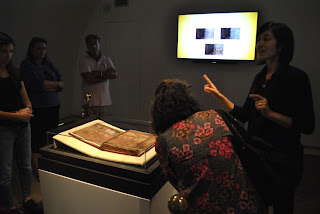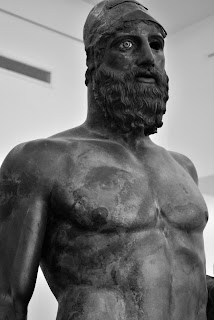 Via Appia is the Roman road which links Roma caput mundi with Brindisi door to the Orient.
Via Appia is the Roman road which links Roma caput mundi with Brindisi door to the Orient.Built up between 4th and 3rd century BC, via Appia went down in history as regina viarum.
The extension of via Appia came along with the Roman military expansion.
 533 kilometres long, the road is covered of smooth volcanic stones (basoli). Cambered in the middle to let the water run off, it was built with ditches on both sides, protected by retaining walls.
533 kilometres long, the road is covered of smooth volcanic stones (basoli). Cambered in the middle to let the water run off, it was built with ditches on both sides, protected by retaining walls. 
The map shows Via Appia (white), which main places were Capua, Beneventum, Silvium (Gravina in Puglia) and Tarentum.
A couple of months ago, Feltrinelli has published Appia by Paolo Rumiz.
This book is the result of a long walk undertaken by Paolo Rumiz and his companions (Riccardo, Alessandro and Irene) who have covered via Appia on foot.
Italy has an immense cultural and archaeological heritage, it's so huge that the Italian institutions seem not always able to preserve it.
As result of this, Philippe Daverio has urged the world to get involved in assisting Italy to save its immense cultural heritage.
Indeed, he has promoted years ago the project Save Italy, stating that the Italian cultural heritage belongs to the whole western world, not just to Italy.
According to enhancemyvocabulary.com, 60% of English words have Latin roots.
As occurred to via Appia, Italy has deliberately sold off its cultural heritage to private interests, linked mainly to property investment.
Antonio Cederna was the first to defend via Appia against politicians, speculators, architects and functionaries implicated in the via Appia plunder.
On 8th Septemebre 1953, Il Mondo published the Antonio Cederna's j'accuse "Via Appia should have been religiously saved because for centuries talented men from all around the world have loved, described, painted, sung it […] Via Appia should have been saved like the Acropolis of Athens".
On 25 August 2016, Masseria Jesce (Altamura), a fantastic masseria which was once a roadhouse of via Appia, has hosted Paolo Rumiz and the filmmaker Alessandro Scillitani to discuss about their trip discovering and mapping Via Appia.

"A journey like this, made on foot, gives you the feeling that the space turns expanded, deep". Paolo Rumiz begins.
"By living a sedentary life, we do not cultivate the skill of reading the body language of people we encounter. Talking about this journey, when we came across the locals, they first looked at us suspiciously, then turned calmed, finally they became interested in what we were doing". He continues.
"The best moment to undertake a long walk is when your head and hearth is full, when you have had enough" In other words, walking is therapeutical, and I fully agree with Paolo Rumiz.
He says "During a meeting in Matera, someone said that this journey had a strong political implication, in the sense that it shifts the barycenter to the South of Italy".
"Via Appia is unique. It makes sense to walk from Rome to Brindisi and vice versa. In other words, the Roman legions came down to Brindisi as well as in the Middle-age the crusades walked along via Appia to reach Brindisi and departing for the Holy land. On the other hand, Catholicism arrived in Rome from the South."
"We have met so many peasants. It was great to talk with them. I remember one of them in Gravina in Puglia. He thought we were grave robbers. "Here the soil conceals so many graves ascribable to Silvium times" he justified himself". Paolo says.
"The South requires a new narration, free of stereotypes. It must be done also because of the current historical and geopolitical situation".

Alessandro has made a documentary from this journey.
"It took us 30 days to cover via Appia. I was struck by the sound of dialects, by random encounters, by the beauty of the landscape. I have filmed the communities we came across" Alessandro says.
The talk goes on till midnight.
Outside is dark, and a fresh air grabs our senses.
We are invited to visit the crypt of masseria Jesce, adorned by frescos which echo the Byzantine ones.
In this awesome scenario, a musician duo is going to play music to entertain the audience.
They are Massimiliano Di Carlo&Veronika Otto, respectively from Ascoli Piceno and Berlin.
Their mission is discovering songs from old people and propose them to their audience.
Massimiliano begins singing a Mongolian song, made by just one note. It's an ancestral sound.
Then, they offer us a fantastic tammurriata, explaining us its cultural roots. Just to clarify, tammurriata is the Neapolitan version of tarantella, "a sound brought by ancient Greeks in the south of Italy. It spread till Ancona, though" Massimiliano points out.
Finally, the duo offer us a typical song called Saltarello, a kind of tarantella typical of center Italy.
After their fantastic performance, I get closer to Massimiliano and ask his name "you know, I write a blog and I'd like to mention you guys because you really do a great job".
While talking with Massimiliano, Paolo Rumiz gets closer and listen to us.
"Of course, I will write about Paolo Rumiz and his great book either" I say.
Paolo Rumiz replays "Well, Massimiliano needs to be reported more than me".
I answer: "Well, I need it too".
Both of them burst laughing. I laugh too.
It's 1 o'clock. Outside it's getting cold but the fire burns inside me.
Tonight I have had great time and learned a lot.





















































